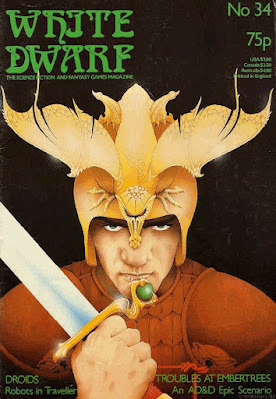White Dwarf: Issue #34
 Issue #34 of White Dwarf (October 1982) features a cover by Emmanuel, the artist responsible for the cover of the Fiend Folio. Although it's a very simple piece in terms of composition, I've always been quite taken with it. Almost as interesting is the fact that the cover describes the issue's AD&D adventure, "Troubles at Embertrees," as "epic." Such hyperbolic language is commonplace nowadays, but I was rather surprised to see it used here. I'll have a little more to say on this topic when we look at the adventure in question.
Issue #34 of White Dwarf (October 1982) features a cover by Emmanuel, the artist responsible for the cover of the Fiend Folio. Although it's a very simple piece in terms of composition, I've always been quite taken with it. Almost as interesting is the fact that the cover describes the issue's AD&D adventure, "Troubles at Embertrees," as "epic." Such hyperbolic language is commonplace nowadays, but I was rather surprised to see it used here. I'll have a little more to say on this topic when we look at the adventure in question."Droids" by Andy Slack is yet another attempt to provide rules for robots in Traveller, which somewhat inexplicably lacked them (and wouldn't get official rules for them until 1986). Unlike many such articles, Slack doesn't present a system for creating robots patterned after the rules for starship construction (or vehicles in Striker). Instead, he simply offers up many examples of robot models, such as robodocs, valet droids, and guardbots. It's a reasonable approach and one I personally like, since I've rarely cared much for "build-your-own" systems, though I imagine it would be something of a disappointment for the gearheads that Traveller tends to attract.
"Space Invader" by Mike Costello is a brief article discussing the pros and cons of purchasing a "microcomputer," as personal computers were sometimes called back then, for use with RPGs. The article is mostly of interest as a historical artifact from the dawn of the PC era. On many levels, the same can be said of Part I of Lewis Pulsipher's "A Guide to Dungeon Mastering." In this article, Pulsipher covers many well-worn topics about how to create and set up adventures. While most of his advice is solid, I don't think any of it would come as a surprise to referees today, since what he says had long since passed into the realm of conventional wisdom. That's no knock against the article, only an acknowledgment that there's been a lot of water under the bridge in the last four years (!).
"Open Box" reviews three RPG products, starting with Cults of Terror for RuneQuest, which receives a rating of only 6 out of 10. Why it's judged relatively harshly is unclear from the review, since the reviewer calls it "tremendous stuff." Meanwhile, FGU's Aftermath! is given 10 out of 10, albeit by a different reviewer, and even I, a fan of the game, think that's a bit much. Finally, Chaosium's Worlds of Wonder receives 7 out of 10; this seems fair, given that three included games are more "skeletons" than fully-fleshed out systems. "Runebeasts" presents two new monsters for use with RuneQuest, in this case the humanoid pterodactyls known as the Vrak and the Nachak, weasel-like beings associated with the Darkness and Disorder runes.
"Trouble at Embertrees" by Paul Vernon is a lengthy introductory scenario for use with AD&D characters of levels 1–2. Like so many White Dwarf scenarios, this one is presented in tiny, dense type and is filled with loads of details, some of them quite extraneous to the actual play of the adventure. The basic set-up is that the characters are hired by a woodcarver who wants them to investigate rumors of strange goings-on at Embertrees, a remote village named after the magical Embertree that grows nearby. Once at Embertrees, the characters are thrown into a mess of conflicting factions, allegiances, and secrets, all presented in a way I found both intriguing and downright confusing. I think there's a good adventure here, buried under all the detail, but it's hard to determine, based on its organization (or, rather, lack thereof). Whether it deserves to be touted as "epic," I can't rightly say, but there can be little doubt that there's a lot here for the referee to wade through before he even thinks of running it.
"Morality in Traveller" is an odd little article by Bob McWilliams in which the author is reacting to the apparent fact that many Traveller characters behave badly in adventures and campaigns, owing in part to the game's lack of a morality/alignment system à la D&D. It's a very strange thing to say in my opinion, but then I rarely had to deal with the kind of amoral behavior McWilliams alludes to. Duncan Bisatt's "The Mahwrs" introduces a bat-like alien race for use with Traveller – nothing to write home about in my opinion.
"Fiend Factory" this months focuses on "More Dead than Alive," meaning five new types of undead or undead-like creatures. I'm a sucker for new undead, so I enjoyed this article more than I expected. Finally, "Treasure Chest" details five new magical weapons, another favorite topic of mine, though I can't say any of the five detailed here are stand outs.
This is another solid, workmanlike issue, though, with the exception of "Trouble at Embertrees," of whose actual value I am still not certain, most of its contents are utterly ephemeral. I don't mean to be harsh; that is the nature of periodicals, after all, even ones as storied as White Dwarf. Still, I will confess to some small disappointment that issue #34 was not as memorable as its immediate predecessors.
James Maliszewski's Blog
- James Maliszewski's profile
- 3 followers



